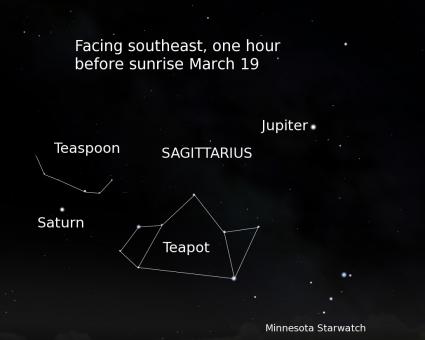Northern Sky: March 16-29, 2019
NORTHERN SKY – By Deane Morrison
March 16-29 2019
We’re now deep into spring equinox time, when the sun climbs fastest through the northern sky. The equinox happens at 4:58 p.m. on March 20, and Grand Marais gains three minutes and 28 seconds of daylight per day for two weeks around that date. But Anchorage, Alaska gains five minutes and 44 seconds, while in Trondheim, Norway, they’re gaining six minutes and 19 seconds. Trondheim gets more than an hour of extra daylight just during the 10 days straddling the equinox.
These ultra-rapid changes shouldn’t be too surprising. For example, in Trondheim, the day length goes from about four and a half hours in December to about twenty and a half in June. When the day length has to increase that much in just six months, it’s going to change pretty fast. And it’s fastest in March because that’s when the sun moves northward most rapidly.
At the equinox, neither pole is pointing toward the sun, and the day length is the same, theoretically, all over the planet. We actually get slightly more than 12 hours of daylight on the equinoxes because Earth’s atmosphere is a gigantic lens that allows us to see the sun for a few minutes before it rises and after it sets.
The equinoxes are also times of switchover. During the winter, the farther north you go, the shorter the day length. After the spring equinox, it’s the other way around, and as you go north, the day length increases.
All this is due to Earth orbiting around the sun while being tilted on its axis. That tilt doesn’t change during the course of a year. The North Pole always points to the same spot in the sky, near the North Star, and it’s our orbital motion that makes it point toward or away from the sun, or neither, depending on Earth’s position.
If that’s hard to visualize, get an apple and face a wall. Tilt the apple a little so that the stem—the apple’s north pole—points somewhat upward and toward the wall. Then, without spinning or pivoting the apple in any way, move it counterclockwise in a circle and imagine the sun in the center. Move your arm horizontally, as if stirring a pot, keeping the apple pointed toward that same wall. When it’s closest to you, the apple tilts toward the sun, like Earth at the northern summer solstice. When it’s farthest from you, it tilts away from the sun. That’s the winter solstice. At the midway points it tilts neither toward nor away from the sun, and those are the equinoxes.
Okay. In the sky. Jupiter is well up in the south in the predawn hour, Saturn is much dimmer and off to the lower left of Jupiter, and Venus makes it over the eastern horizon just as the sun’s rays start to wash everything out.
In the evening, Mars is still up in the west after nightfall. It’s been kind of lonely, but some visitors are on the way. The Pleiades star cluster and the bright star Aldebaran, the eye of Taurus, the bull, are moving closer to Mars every night. Best viewing starts the 22nd of March, at about 8:30 or 9 o’clock, when the sky will be dark but the moon won’t be up yet.
March’s full moon comes right after the equinox, at 8:43 p.m. on the 20th. The moon will be just a day past perigee, its closest approach to Earth in a lunar cycle, and that means we get our third supermoon in a row. This one rises over Grand Marais at 6:52 p.m., less than two hours before fullness, so it’ll come up very round as well as very big.
Tweet




